NCERT Solutions for Class 12 Maths Chapter 10 - Vectors - Miscellaneous Exercise
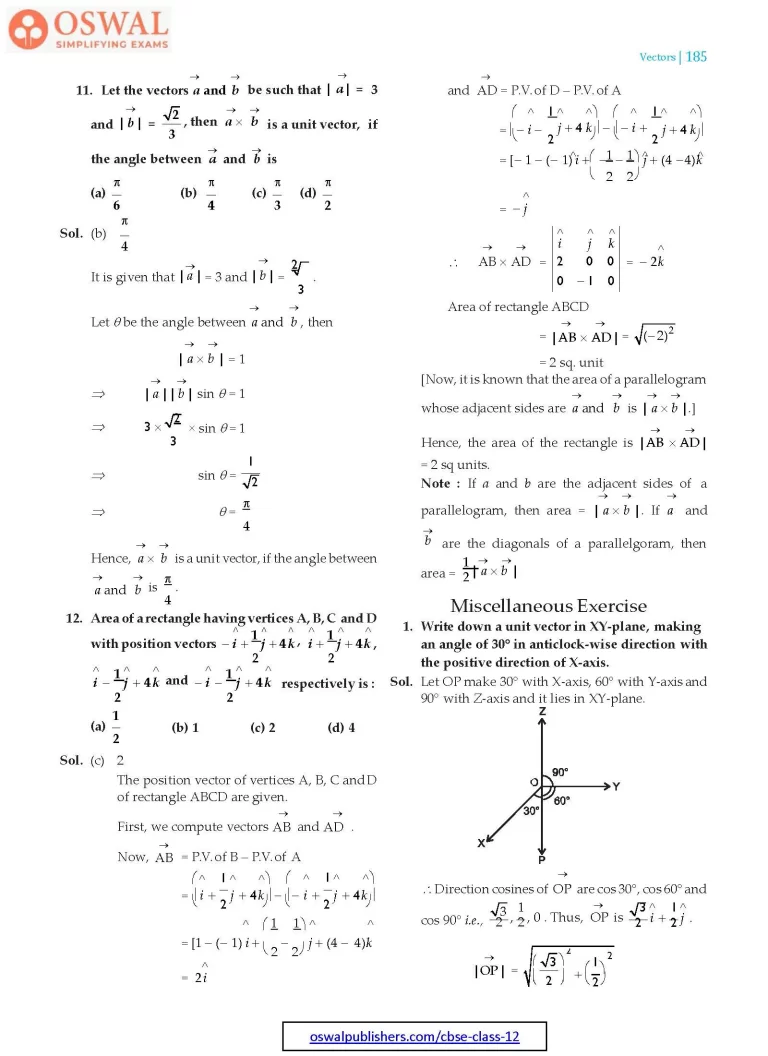

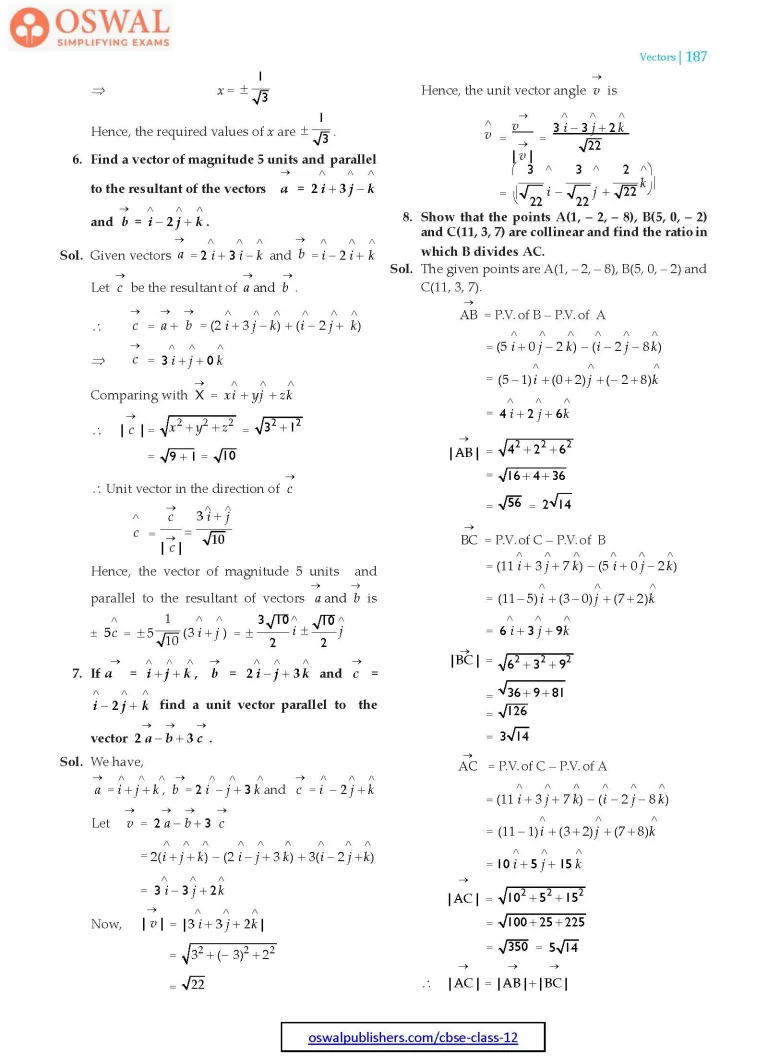
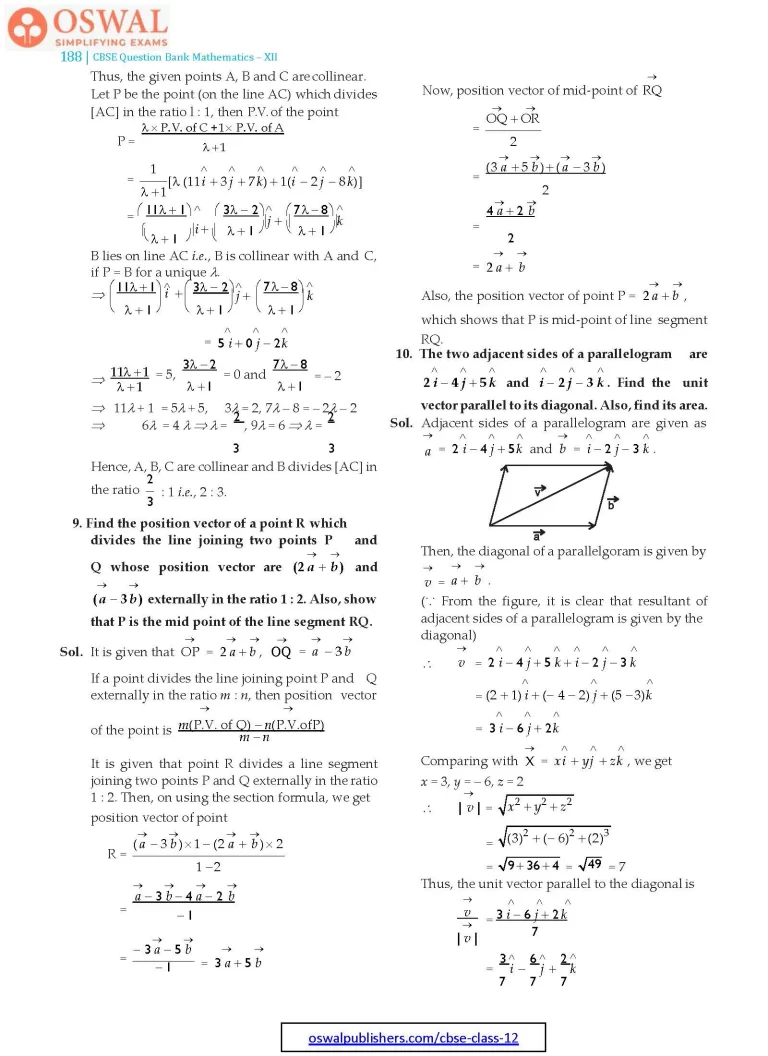
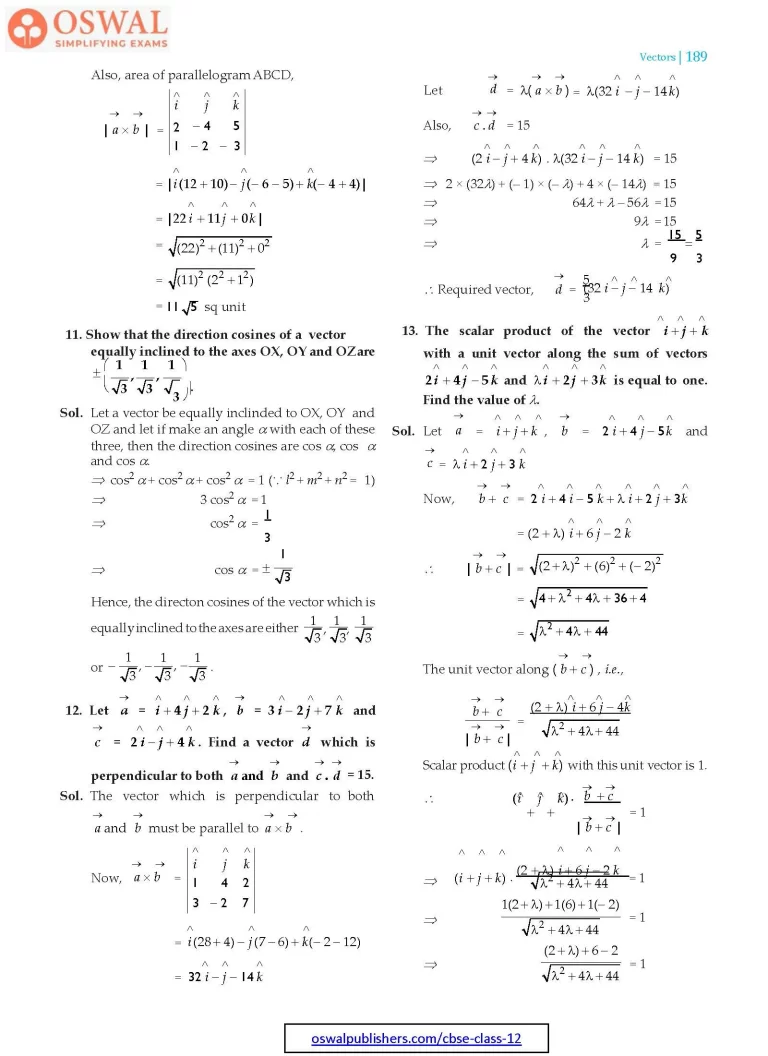
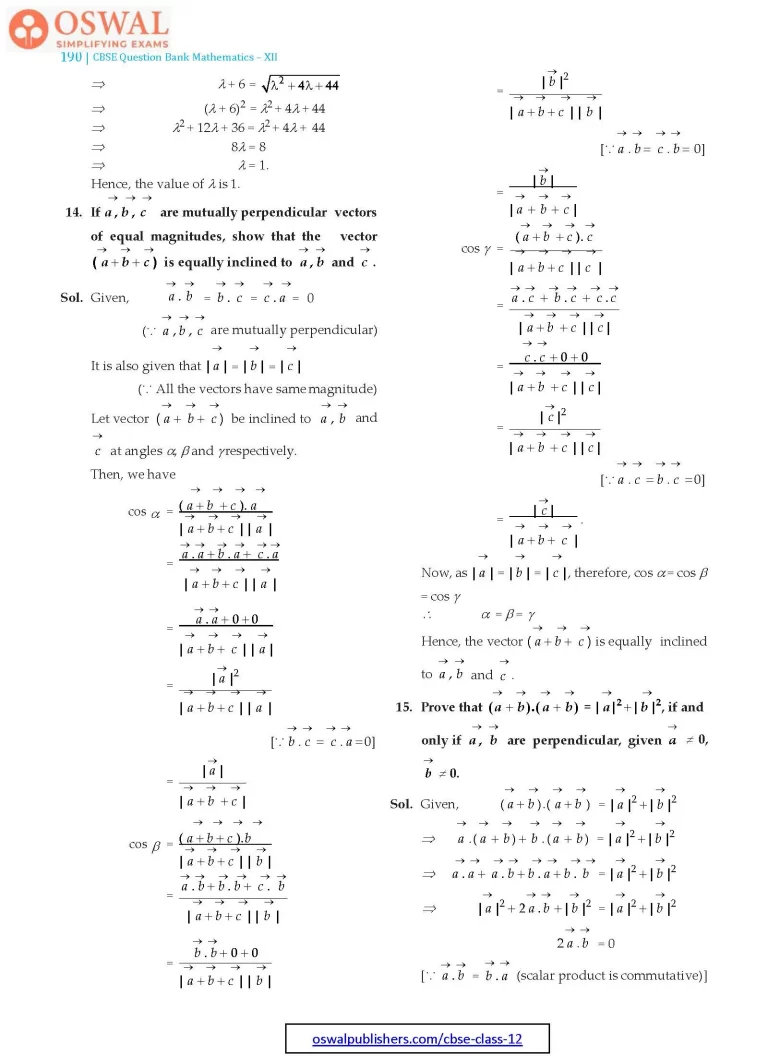
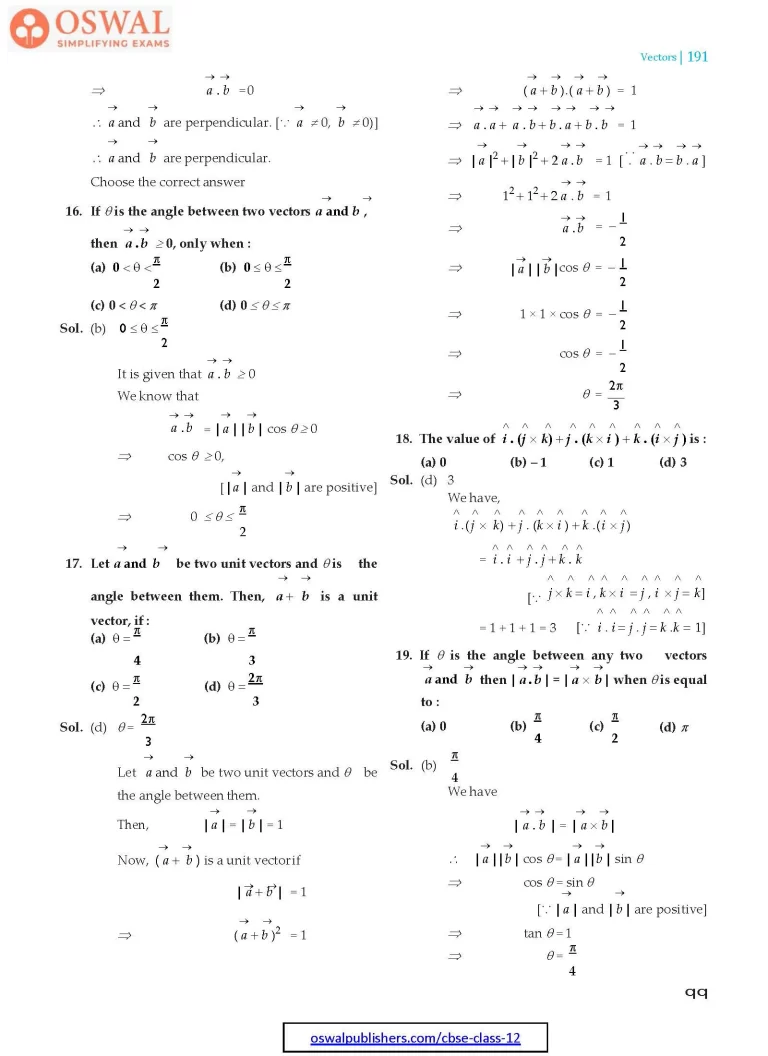
Access Exercises of Class 12 Maths Chapter 10 – Vectors
Exercise 10.1 Solutions 5 Questions
Exercise 10.2 Solutions 19 Questions
Exercise 10.3 Solutions 18 Questions
Exercise 10.4 Solutions 12 Questions
Miscellaneous Exercise on Chapter 10 Solutions 19 Questions
Miscellaneous Exercise
1. Write down a unit vector in XY-plane, making an angle of 30° in anticlock-wise direction with the positive direction of X-axis.
Sol. Let OP make 30° with X-axis, 60° with Y-axis and 90° with Z-axis and it lies in XY-plane.

$$\therefore\space\text{Direction cosines of}\space\vec{\text{OP}}\\\text{are cos 30°, cos 60° and}\\\text{cos 90\degree i.e.,}\frac{\sqrt{3}}{2},\frac{1}{2},0.\space\text{Thus,}\space\vec{\text{OP}}\space\text{is}\\\frac{\sqrt{3}}{2}\hat{i}+\frac{1}{2}\hat{j}\\|\vec{\text{OP}}| = \sqrt{\bigg(\frac{\sqrt{3}}{2}\bigg)^{2} + \bigg(\frac{1}{2}\bigg)}\\=\sqrt{\frac{3}{4}+\frac{1}{4}}\\=\sqrt{1} = 1$$
which is required unit vector of XY-plane.
2. Find the scalar components and magnitude of the vector joining the points P(x1, y1, z1) and Q(x2, y2, z2).
Sol. The vector joining the points P(x1, y1, z1) and Q(x2, y2, z2) can be obtained by,
$$\vec{\text{OP}} = \text{P.V. of Q – P.V. of P}\\ =(x_2\hat{i} + y_2\hat{j} + z_2\hat{k}) - (x_1\hat{i} +y_1\hat{j}+z_1\hat{k})\\=(x_2-x_1)\hat{i} + (y_2-y_1)\hat{j} + (z_2-z_1)\hat{k}\\\therefore\space\text{Scalar components of}\space\vec{\text{PQ}}\\\space\text{are}\space x_2-x_1, y_2-y_1,z_2-z_1.\\\therefore\space\text{Magnitude of}|\vec{\text{PQ}}|\\=\sqrt{(x_2-x_1)^{2}+(y_2-y_1)^{2}+(z_2-z_1)^{2}}$$
3. A girls walks 4 km towards west, then she walks 3 km in a direction 30° east of north and stops. Determine the girl's displacement from her initial point of departure.
Sol. Let O and B be the initial and final positions of the girl respectively.

Then, the girl's position can be shown as in the figure.
$$\text{Now, we have}\space \vec{\text{OA}} = 4\hat{i}\\\vec{\text{AB}} =\hat{i}|\vec{\text{AB}}|\text{cos} 60\degree + \hat{j}|\vec{\text{AB}}|\text{sin}60\degree\\(\vec{\text{AB}}\space \text{cos} \space60\degree\text{is component}\space\vec{\text{AB}},\\\text{along X-axis and}\space \vec{\text{AB}\space \text{sin 60\degree is component}}\\\text{of\space}\vec{\text{AB} = \text{along Y-axis})}\\ = \hat{i}\space 3×\frac{1}{2}+\hat{j}\space 3×\frac{\sqrt{3}}{2}\\=\frac{3}{2}\hat{i} + \frac{3\sqrt{3}}{2}\hat{j}$$
By the triangle law of vector addition, we have
$$\vec{\text{OB}} =\vec{\text{OA}} + \vec{\text{AB}}\\=(-4\hat{i}) + \bigg(\frac{3}{2}\hat{i} + \frac{3\sqrt{3}}{2}\hat{j}\bigg)\\= \bigg(-4 + \frac{3}{2}\bigg)\hat{i} + \frac{3\sqrt{3}}{2}\hat{j}\\ =\bigg(\frac{-8+3}{2}\bigg)\hat{i} + \frac{3\sqrt{3}}{2}\hat{j}\\=\frac{-5}{2}\hat{i} + \frac{3\sqrt{3}}{2}\hat{j} $$
Hence, the girl's displacement from her initial point of departure is
$$\frac{-5}{2}\hat{i} + \frac{3\sqrt{3}}{2}\hat{j}. $$
$$\textbf{4.\space If}\space \vec{\textbf{a}} \space\textbf{=}\space\vec{\textbf{b}} +\vec{\textbf{c}}\textbf{,}\space\textbf{then is it true that}\\\textbf{|}\vec{\textbf{a}}\textbf{|} \textbf{=}\textbf{|}\vec{\textbf{b}}\textbf{|} \textbf{+}|\vec{\textbf{c}}|\space \textbf{?}\space\textbf{Justify you answer.}\\\textbf{Sol.\space}\text{In triangle ABC, let}\space\\\vec{\text{CB}} =\vec{a},\vec{\text{CA}} =\vec{b}\space\text{and}\space \vec{\text{AB}} = \vec{c}$$
(as shown in the following figure)
Now , by the triangle law of addition, we have $$\vec{a} = \vec{b}+\vec{c}.$$
It is clearly known that
$$|\vec{a}|,|\vec{b}|\space\text{and}|\vec{c}|\space\\\text{represent the side of}\Delta \text{ABC.}$$
5. Find the value of x for which
$$\textbf{x}(\hat{\textbf{i}}+\hat{\textbf{j}} + \hat{\textbf{k}})\space\textbf{is a unit vector.}$$
$$\textbf{Sol.\space}\text{Given,\space}x(\hat{i} +\hat{j} + \hat{k})\\\space\text{is a unit vector, therefore,}\\|x(\hat{i} + \hat{j}+\hat{k})|=1\\\Rarr\space |x\hat{i} +x\hat{j} + x\hat{k}|=1\\\Rarr\space|\sqrt{x^{2}+x^{2}+x^{2}}|=1\\\Rarr\space \sqrt{3x^{2}}=1\\\Rarr\space \pm\sqrt{3x}=1\\\Rarr\space x = \pm\frac{1}{\sqrt{3}}\\\text{Hence, the required values of x are}\\\pm\frac{1}{\sqrt{3}}.$$
6. Find a vector of magnitude 5 units and parallel to the resultant of the vectors
$$\vec{\textbf{a}} \textbf{= 2}\hat{\textbf{i}} \textbf{+ 3}\hat{\textbf{j}}\textbf{-}\hat{\textbf{k}}\space\textbf{and}\space \vec{\textbf{b}} \textbf{=}\hat{\textbf{i}}\textbf{-2}\hat{\textbf{j}}\textbf{+}\hat{\textbf{k}}\\\textbf{Sol.}\space\text{Given vectors }\vec{a} =2\hat{i} +3\hat{i}-\hat{k}\\\text{and}\space\vec{b} = \hat{i} - 2\hat{j} +\hat{k}\\\text{Let}\space\vec{c}\space\text{be the resultant of}\space\vec{a}\space\text{and}\space\vec{b}.\\\therefore\space\vec{c} = \vec{a} +\vec{b}\\=(2\hat{i}+3\hat{j}-\hat{k}) + (\hat{i}-2\hat{j}+\hat{k})\\\Rarr\space \vec{c} = 3\hat{i}+\hat{j}+0\hat{k}\\\text{Comparing with}\space\vec{\text{X}} = x\hat{i}+y\hat{j}+z\hat{k}\\\therefore\space |\vec{c}| = \sqrt{x^{2}+y^{2}+z^{2}}\\=\sqrt{3^{2}+1^{2}}\\=\sqrt{9+1}=\sqrt{10}\\\therefore\space \text{Unit vector in the direction of}\\\hat{c} = \frac{\vec{c}}{|\vec{c}|} =\frac{3\hat{i} +\hat{j}}{\sqrt{10}}$$
Hence, the vector of magnitude 5 units and parallel to the resultant of vectors
$$\vec{a}\space\text{and}\space\vec{b}\space\text{is}\\\pm 5\hat{c} = \pm 5\frac{1}{\sqrt{10}}(3\hat{i} +\hat{j}) \\=\pm\frac{3\sqrt{10}}{2}\hat{i}\pm\frac{\sqrt{10}}{2}\hat{j}$$
$$\textbf{7.\space If}\space\vec{\textbf{a}}\space\textbf{=}\space\hat{\textbf{i}}\textbf{+}\hat{\textbf{j}}\textbf{+} \hat{\textbf{k}},\space \vec{\textbf{b}} \textbf{= 2}\hat{\textbf{i}} \textbf{-}\textbf{j} \textbf{+ 3}\hat{\textbf{k}}\space\\\textbf{and}\space\vec{\textbf{c}} \space\textbf{=} \space\hat{\textbf{i}}\textbf{-2}\hat{\textbf{j}}\textbf{+}\hat{\textbf{k}}\space\textbf{find a unit}\\\textbf{vector parallel to the vector}\space\\ \textbf{2}\vec{\textbf{a}}-\vec{\textbf{b}} \textbf{+ 3}\vec{\textbf{c}}.$$
Sol. We have,
$$\vec{a} =\hat{i} + \hat{j} +\hat{k},\\\vec{b} = 2\hat{i} -\hat{j} + 3\hat{k}\space\text{and}\space\vec{c} =\hat{i} -2\hat{j}+\hat{k}\\\text{Let}\space \vec{v} = 2\vec{a} - \vec{b} + 3\vec{c}\\=2(\hat{i}+\hat{j}+\hat{k})-(2\hat{i}-\hat{j}+3\hat{k})\\ +\space 3(\hat{i}-2\hat{j}+\hat{k})\\=3\hat{i} -3\hat{j}+2\hat{k}\\\text{Now,}\space |\vec{v}| = 3\hat{i} + 3\hat{j}+ 2\hat{k}\\=\sqrt{3^{2}+(-3)^{2}+2^{2}}\\=\sqrt{22}\\\text{Hence, the unit}\space\text{vector angle}\\\vec{v}\space\text{is}\\\hat{v} =\frac{\vec{v}}{|\vec{v}|} =\frac{3\hat{i}-3\hat{j}+2\hat{k}}{\sqrt{22}}$$
$$=\bigg(\frac{3}{\sqrt{22}}\hat{i} -\frac{3}{\sqrt{22}}\hat{j} + \frac{2}{\sqrt{22}}\hat{k}\bigg)$$
8. Show that the points A(1, – 2, – 8), B(5, 0, – 2) and C(11, 3, 7) are collinear and find the ratio in which B divides AC.
Sol. The given points are A(1, – 2, – 8), B(5, 0, – 2) and C(11, 3, 7).
$$\vec{\text{AB}} =\text{P.V. of B – P.V. of A}\\ =(5\hat{i} + 0\hat{j}-2\hat{k})-(\hat{i}-2\hat{j}-8\hat{k})\\=(5-1)\hat{i}+(0+2)\hat{j}+(-2+8)\hat{k}\\= 4\hat{i}+2\hat{j}+6\hat{k}\\|\vec{\text{AB}}| = \sqrt{4^{2}+2^{2}+6^{2}}\\=\sqrt{16+4+36}\\=\sqrt{56} = 2\sqrt{14}\\\vec{\text{BC}} = \text{P.V. of C – P.V. of B}\\=(11\hat{i} +3\hat{j}+7\hat{k}) - (5\hat{i} + 0\hat{j}-2\hat{k})\\=(11-5)\hat{i}+(3-0)\hat{j}+(7+2)\hat{k}\\= 6\hat{i}+3\hat{j}+9\hat{k}\\|\vec{\text{BC}}| =\sqrt{6^{2} + 3^{2}+9^{2}}\\=\sqrt{36 + 9 + 81}\\=\sqrt{126}$$
$$= 3\sqrt{14}\space\\\vec{\text{AC}} = \text{P.V. of C – P.V. of A}\\=(11\hat{i} + 3\hat{j}+7\hat{k}) -(\hat{i}-2\hat{j}-8\hat{k})\\=(11-1)\hat{i} + (3+2)\hat{j}+(7+8)\hat{k}\\=10\hat{i}+5\hat{j}+15\hat{k}\\|\vec{\text{AC}}| = \sqrt{10^{2}+5^{2}+15^{2}}\\ =\sqrt{100+25 + 225}\\=\sqrt{350} =5\sqrt{14}\\\therefore\space |\vec{\text{AC}}| =|\vec{\text{AB}}| +|\vec{\text{BC}}|$$
Thus, the given points A, B and C are collinear.
Let P be the point (on the line AC) which divides [AC] in the ratio l : 1, then P.V. of the point
$$\text{P} =\frac{\lambda×\text{P.V. of C}+1×\text{P.V. of A}}{\lambda +1}$$
$$=\frac{1}{\lambda+1}\lbrack(11\hat{i}+3\hat{j}+7\hat{k})+\\1(\hat{i}-2\hat{j}-8\hat{k})\rbrack\\=\bigg(\frac{11\lambda+1}{\lambda+1}\bigg)\hat{i}+\bigg(\frac{3\lambda-2}{\lambda-1}\bigg)\hat{j}+\\\bigg(\frac{7\lambda-8}{\lambda+1}\bigg)\hat{k}\\= 5\hat{i}+0\hat{j}-2\hat{k}\\\Rarr\space \frac{11\lambda+1}{\lambda+1}=5,\frac{3\lambda-2}{\lambda+1}=0\\\text{and}\space\frac{7\lambda-8}{\lambda+1}=-2$$
$$\Rarr\space 11\lambda+1 =5\lambda+5,\space 3\lambda=2,\\ 7\lambda-8 =-2\lambda-2\\\Rarr\space 6\lambda=4\lambda\\\Rarr\space \frac{2}{3}, 9\lambda =6\\\Rarr\space \lambda =\frac{2}{3}$$
Hence, A, B, C are collinear and B divides [AC] in
$$\text{the ratio}\space\frac{2}{3}\space :\text{i.e., 2:3.}$$
9. Find the position vector of a point R which divides the line joining two points P and Q whose position vector are
$$\textbf{(2}\vec{\textbf{a}} \textbf{+} \vec{\textbf{b}}\textbf{)}\space\textbf{and}\space \textbf{(}\vec{\textbf{a}} - 3\vec{\textbf{b}}\textbf{)}$$
externally in the ratio 1 : 2. Also, show that P is the mid point of the line segment RQ.
Sol. It is given that
$$\vec{\text{OP}} =\space 2\vec{a} + \vec{b},\vec{\text{OQ}} = \vec{a} - 3 \vec{b}$$
If a point divides the line joining point P and Q externally in the ratio m : n, then position vector of the point is
$$\frac{m(\vec{\text{PV}} \text{of Q}) - n(\vec{\text{P.V.}} \text{of P})}{\text{m-n}}$$
It is given that point R divides a line segment joining two points P and Q externally in the ratio 1 : 2. Then, on using the section formula, we get position vector of point
$$\text{R} = \frac{(\vec{a} - 3\vec{b})×1 - (2\vec{a} + \vec{b})×2}{1-2}\\=\frac{\vec{a} - 3\vec{b}-4\vec{a}-2\vec{b}}{\normalsize-1}\\=\frac{-3\vec{a} - 5\vec{b}}{-1} = 3\vec{a}+5\vec{b}\\\text{Now , position vector of mid-point of}\space\\\vec{\text{PQ}}\\=\frac{\vec{\text{OQ}}+\vec{\text{OR}}}{2}\\=\frac{(3\vec{a}+5\vec{b}) + (\vec{a} - 3\vec{b})}{2}\\=\frac{4\vec{a}+2\vec{b}}{2}\\= 2\vec{a} + \vec{b}$$
Also, the position vector of point
$$\text{P = 2}\vec{\text{a}} + \vec{\text{b}}, $$
which shows that P is mid-point of line segment RQ.
10. The two adjacent sides of a parallelogram are
$$\textbf{2}\hat{\textbf{i}}\textbf{- 4}\hat{\textbf{j}}\textbf{+ 5}\hat{\textbf{k}}\space\textbf{and}\space \vec{\textbf{b}} \textbf{=}\hat{\textbf{i}}\textbf{-2}\hat{\textbf{j}}\textbf{- 3}\hat{\textbf{k}}\textbf{.}$$Find the unit vector parallel to its diagonal. Also, find its area.
Sol. Adjacent sides of a parallelogram are given as
$$\vec{a} = 2\hat{i}-4\hat{j}+5\hat{k}\space\text{and}\space\vec{b} =\hat{i} - 2\hat{j}-3\hat{k}. $$

Then, the diagonal of a parallelgoram is given by
$$\vec{v} = \vec{a}+\vec{b}.$$
(∵ From the figure, it is clear that resultant of adjacent sides of a parallelogram is given by the diagonal)
$$\therefore\space \vec{v} = 2\hat{i}-4\hat{j}+5\hat{k}+\hat{i}-2\hat{j}-3\hat{k}\\=(2+1)\hat{i}+(-4-2)\hat{j}+(5-3)\hat{k}\\=3\hat{i}-6\hat{j}+2\hat{k}\\\text{Comparing with}\space \\\vec{\text{X}} = x\hat{i}+y\hat{j}+z\hat{k},\space\text{we get}$$
x = 3, y = – 6, z = 2
$$\therefore\space |\vec{\text{V}}| = \sqrt{x^{2}+y^{2}+z^{2}}\\=\sqrt{(3)^{2}+(-6)^{2}+(2)^{3}}\\=\sqrt{9+36+4} =\sqrt{49} =7$$
Thus, the unit vector parallel to the diagonal is
$$\frac{\vec{v}}{|\vec{v}|} =\frac{3\hat{i} -6\hat{j}+2\hat{k}}{7}\\=\frac{3}{7}\hat{i}-\frac{6}{7}\hat{j}+\frac{2}{7}\hat{k}$$
Also, area of parallelogram ABCD,
$$|\vec{a}×\vec{b}| = \begin{vmatrix}\hat{i} & \hat{j} & \hat{k}\\ 2 &-4 &5\\ 1&-2 &-3\end{vmatrix}\\=|\hat{i}(12 + 10) -\hat{j}(-6-5) + \hat{k}(-4+4)|\\=|22\hat{i} + 11\hat{j} + 10\hat{k}|\\=\sqrt{(22)^{2}+(11)^{2}+0^{2}}\\=\sqrt{(11)^{2}(2^{2}+1^{2})}\\= 11\sqrt{5}\space\text{sq unit}$$
11. Show that the direction cosines of a vector equally inclined to the axes OX, OY and OZ are
$$\pm\bigg(\frac{\textbf{1}}{\sqrt{\textbf{3}}}\textbf{,}\frac{\textbf{1}}{\sqrt{\textbf{3}}}\textbf{,}\frac{\textbf{1}}{\sqrt{\textbf{3}}}\bigg)\textbf{.}$$
Sol. Let a vector be equally inclinded to OX, OY and OZ and let if make an angle a with each of these three, then the direction cosines are cos a, cos a and cos α.
$$\Rarr\space \text{cos}^{2}\alpha + \text{cos}^{2}\alpha + \text{cos}^{2}\alpha=1\\(\because\space l^{2}+m^{2}+n^{2}=1)\\\Rarr\space \text{3 cos}^{2}\alpha=1\\\Rarr\space \text{cos}^{2}\alpha = \frac{1}{3}\\\Rarr\space \text{cos}\space\alpha = \pm\frac{1}{\sqrt{3}}$$
Hence, the directon cosines of the vector which is equally inclined to the axes are either
$$\frac{1}{\sqrt{3}},\frac{1}{\sqrt{3}},\frac{1}{\sqrt{3}}\space\text{or}\space-\frac{1}{\sqrt{3}},-\frac{1}{\sqrt{3}},-\frac{1}{\sqrt{3}}.$$
$$\textbf{12.\space}\textbf{Let}\space \vec{\textbf{a}} \space\textbf{=}\space \hat{\textbf{i}} \textbf{+ 4}\hat{\textbf{j}} \textbf{+ 2}\hat{\textbf{k}},\space \vec{\textbf{b}} \textbf{= 3}\hat{\textbf{i}}\textbf{-2}\textbf{j} \textbf{+ 7}\hat{\textbf{k}}\\\textbf{and}\space\vec{\textbf{c}} \textbf{= 2}\hat{\textbf{i}}\textbf{-}\hat{\textbf{j}} \textbf{+ 4}\hat{\textbf{k}}.\space\textbf{Find a vector}\\\vec{a}\space \textbf{which is perpendicular to both}\\\vec{\textbf{a}}\space\textbf{and}\space\vec{\textbf{b}}\space\textbf{and}\space\vec{\textbf{c}}.\vec{\textbf{d}}\textbf{ = 15}.$$
Sol. The vector which is perpendicular to both
$$\vec{a}×\vec{b}\space\text{must be parallel to}\space\vec{a}×\vec{b}.\\\text{Now,}\space \vec{a}×\vec{b}\begin{vmatrix}\hat{i} &\hat{j}&\hat{k}\\ 1 &4 &2\\3 &-2 &7\end{vmatrix}\\ = \hat{i(28+4)} -\hat{j}(7-6) + \hat{k}(-2-12)\\= 32\hat{i} -\hat{j}-14\hat{k}\\\text{Let}\space \vec{d} = \lambda(\vec{a}×\vec{b})\\=\lambda(32\hat{i} -\hat{j}-14\hat{k})\\\text{Also,}\space \vec{\text{c}}.\vec{\text{d}} = 15\\\Rarr\space (2\hat{i} -\hat{j} + 4\hat{k}).\lambda(32\hat{i} -\hat{j}-14\hat{k})=15\\\Rarr\space 2×(32\lambda) + (\normalsize-1)×(-\lambda) + 4×(-14\lambda) = 15\\\Rarr\space 64\lambda + \lambda - 56\lambda = 15\\\Rarr\space 9\lambda = 15 $$
$$\Rarr\lambda\space = \frac{15}{9}=\frac{15}{3}\\\therefore\space\text{Required vector,}\space \vec{d} = \frac{5}{3}(32\hat{i} -\hat{j}-14\hat{k})$$

Also, it is known that the sum of the lengths of any two sides of a triangle is greater than the third side.
$$\therefore\space |\vec{a}| \lt |\vec{b}|+|\vec{c}|\\\text{Hence, it is not true that}\\|\vec{a}| =|\vec{b}| + |\vec{c}|.$$
13. The scalar product of the vector
$$\hat{\textbf{i}} + \hat{\textbf{j}} + \hat{\textbf{k}}\space\textbf{with a unit vector along}\\\textbf{the sum of vectors}\space \textbf{2}\hat{\textbf{i}} \textbf{+ 4}\hat{\textbf{j}} \textbf{- 5}\hat{\textbf{k}}\space\textbf{and}\\\lambda\hat{\textbf{i}}\textbf{ + 2}\hat{\textbf{j}} \textbf{+ 3}\hat{\textbf{k}}\space\textbf{is equal to one.}\\\textbf{Find the value of}\space\lambda.$$
$$\textbf{Sol.\space}\text{Let}\space \vec{a} = \hat{i} +\hat{j}+ \hat{k},\\\vec{b} = 2\hat{i} + 4\hat{j}-5\hat{k}\space\text{and}\space\\\vec{c} =\lambda \hat{i} + 2\hat{j}+3\hat{k}\\\text{Now,\space}\vec{b} + \vec{c} = 2\hat{i} + 4\hat{i}-5\vec{k}+\lambda\hat{i}+2\hat{j}+3\hat{k}\\ = (2 + \lambda)\hat{i} + 6\hat{j} - 2\hat{k}\\\therefore\space|\vec{b} +\vec{c}| = \\\sqrt{(2 + \lambda)^{2} + (6)^{2} + (-2)^{2}}\\=\sqrt{4 +\lambda^{2} + 4\lambda + 36+4}\\=\sqrt{\lambda^{2} + 4\lambda +44}\\\text{The unit vector along}\space (\vec{b} +\vec{c}),\text{i.e.,}\\\frac{\vec{b}+\vec{c}}{|\vec{b} + \vec{c}|} = \frac{(2 + \lambda)\hat{i} +6\hat{j} -4\hat{k}}{\sqrt{\lambda^{2} + 4\lambda +44}}$$
$$\text{Scalar product}\space (\hat{i} +\hat{j} +\hat{k})\space\text{with}\\\text{this unit vector is 1.}\\\therefore\space (\hat{i} + \hat{j} + \hat{k}).\frac{\vec{b}.\vec{c}}{|\vec{b} + \vec{c}|} = 1\\\Rarr\space (\hat{i} + \hat{j} + \hat{k}).\frac{(2 +\lambda)\hat{i} + 6\hat{j}-2\hat{k}}{\sqrt{\lambda^{2}+4\lambda +44}}=1\\\Rarr\space\frac{1(2 +\lambda) +1(6) + 1(-2)}{\sqrt{\lambda^{2} + 4\lambda +44}}=1\\\Rarr\space \frac{(2 + \lambda) + 6-2}{\sqrt{\lambda^{2} +4\lambda + 44}} = 1\\\Rarr\space\lambda + 6 =\sqrt{\lambda^{2} +4\lambda +44}\\\Rarr\space (\lambda + 6)^{2} = \lambda^{2} + 4\lambda+44\\\Rarr\space \lambda^{2} + 12\lambda+36 =\lambda^{2} + 4\lambda+44$$
$$\Rarr\space 8\lambda = 8\\\Rarr\space \lambda = 1.\\\text{Hence, the value of}\space\lambda\space\text{is 1.}$$
$$\textbf{14.\space}\textbf{If}\space\vec{\textbf{a}},\vec{\textbf{b}},\vec{\textbf{c}}\space\textbf{are mutually perpendicular}\\\textbf{of equal magnitudes, show that the}\\\textbf{vector}\space \textbf{(}\vec{\textbf{a}} + \vec{\textbf{b}} + \vec{\textbf{c}}\textbf{)}\space\textbf{is equally inclined to}\\\vec{\textbf{a}},\vec{\textbf{b}}\space\textbf{and}\space \vec{\textbf{c}.}\\\textbf{Sol.\space}\text{Given}\space\vec{a}.\vec{b} =\vec{b}.\vec{c} =\vec{c}.\vec{a} =0\\(\because\space \vec{a},\vec{b},\vec{c}\space \text{are mutually perpendicular})\\\text{It is also given that}\space|\vec{a}|= |\vec{b}|=|\vec{c}|\\(\because\space \text{All the vectors have same magnitude})\\\text{Let vector}\space (\vec{a} + \vec{b} + \vec{c})\space\text{be inclined to}\space \vec{a}, \vec{b}\\\text{and}\space\vec{c}\space\text{at angles}\space\alpha,\beta\space\text{and}\space\gamma\space\text{respectively.}$$
Then, we have
$$\text{cos}\space\alpha =\frac{(\vec{a} + \vec{b} + \vec{c}).\vec{a}}{|\vec{a} +\vec{b}+\vec{c}||\vec{a}|}\\=\frac{\vec{a}.\vec{a} + \vec{b}.\vec{a} + \vec{c}.\vec{a}}{|\vec{a} + \vec{b} +\vec{c}||\vec{a}|}\\=\frac{\vec{a}.\vec{a} +0+0}{|\vec{a} + \vec{b} + \vec{c}||\vec{a}|}\\=\frac{|\vec{a}|^{2}}{|\vec{a}+ \vec{b} + \vec{c}||\vec{a}|}\\\lbrack\because\space \vec{b}.\vec{c} =\vec{c}.\vec{a} =0\rbrack\\ = \frac{|\vec{a}|}{|\vec{a} + \vec{b} + \vec{c}|}\\\text{cos}\beta =\frac{(\vec{a}+\vec{b} +\vec{c}).\vec{b}}{|\vec{a} + \vec{b}+\vec{c}|||\vec{b}|}$$
$$ = \frac{\vec{a}.\vec{b} + \vec{b}.\vec{b} + \vec{c}.\vec{b}}{|\vec{a} + \vec{b}+ \vec{c}||\vec{b}|}\\=\frac{\vec{b}.\vec{b}+0+0}{|\vec{a} + \vec{b} +\vec{c}||\vec{b}|}\\ = \frac{|\vec{b}|^{2}}{|\vec{a} +\vec{b} + \vec{c}| |\vec{b}|}\\\lbrack\because\space \vec{a} .\vec{b} = \vec{c}.\vec{b} = 0\rbrack\\=\frac{|\vec{b}|}{|\vec{a} +\vec{b} +\vec{c}|}\\\text{cos}\space\gamma = \frac{(\vec{a}+ \vec{b} +\vec{c}).\vec{c}}{|\vec{a} +\vec{b} + \vec{c}||\vec{c}|}$$
$$= \frac{\vec{a}.\vec{c} + \vec{b}.\vec{c} +\vec{c}.\vec{c}}{|\vec{a}+\vec{b}+\vec{c}||\vec{c}|}\\=\frac{\vec{c}.\vec{c} + 0 +0}{|\vec{a} + \vec{b} +\vec{c}||\vec{c}|}\\=\frac{|\vec{c}|^{2}}{|\vec{a} +\vec{b} + \vec{c}||\vec{c}|}\\\lbrack\because\space \vec{a}.\vec{c} = \vec{b}.\vec{c} = 0\rbrack\\= \frac{|\vec{c}|}{|\vec{a} +\vec{b}+ \vec{c}|}.\\\text{Now,\space as}\space |\vec{a}| =|\vec{b}| = |\vec{c}|,\\\text{therefore, cos}\alpha = \text{cos}\beta = \text{cos}\gamma\\\therefore\space \alpha = \beta = \gamma$$
$$\text{Hence, the vector}\space(\vec{a} +\vec{b}+ \vec{c})\space\text{is}\\\text{equally inclined to}\space\vec{a},\vec{b}\space\text{and}\space \vec{c}.$$
$$\textbf{15. Prove that}\space\textbf{(}\vec{\textbf{a}} + \vec{\textbf{b}}\textbf{).}\textbf{(}\vec{\textbf{a}}+ \vec{\textbf{b}}) \textbf{=}\\\textbf{|}\vec{\textbf{a}}\textbf{|}^{\textbf{2}} \textbf{+ |}\vec{\textbf{b}}\textbf{|}^{\textbf{2}} \textbf{,}\space\textbf{if and only if}\space\vec{\textbf{a}},\vec{\textbf{b}}\space\\\textbf{are perpendicular, given}\space\vec{\textbf{a}}\neq \textbf{0},\vec{\textbf{b}}\neq \textbf{0 .}$$
Sol. Given,
$$(\vec{a} + \vec{b}).(\vec{a} + \vec{b}) = |\vec{a}|^{2} + |\vec{b}|^{2}\\\Rarr\space \vec{a}.(\vec{a} +\vec{b}) + \vec{b}.(\vec{a} +\vec{b}) = |\vec{a}|^{2} + |\vec{b}|^{2}\\\Rarr\space \vec{a}.\vec{a} + \vec{a}.\vec{b} +\vec{b}.\vec{a}+\vec{b}.\vec{b}\\=|\vec{a}|^{2}+|\vec{b}|^{2}\\\Rarr\space|\vec{a}|^{2} + 2\vec{a}.\vec{b} + |\vec{b}|^{2} =|\vec{a}|^{2} + |\vec{b}|^{2}\\2\space\vec{a}.\vec{b} = 0\\\lbrack\because\space\vec{a}.\vec{b} = \vec{b}.\vec{a}\space\text{(scalar product is commutative)}\rbrack\\\Rarr\space \vec{a}.\vec{b} = 0\\\therefore\space\vec{a}\space\text{and}\space\vec{b}\space\text{are perpendicular.}\\\lbrack(\because\space\vec{a} \neq 0, \vec{b}\neq 0)\rbrack\\\therefore\space \vec{a}\space\text{and}\space\vec{b}\space\text{are perpendicular.}$$
Choose the correct answer
$$\textbf{16. If}\space\theta\space\textbf{is the angle between two vectors}\space\\\vec{\textbf{a}}\space\textbf{and}\space\vec{\textbf{b}}\textbf{,}\space\textbf{then\space}\vec{\textbf{a}}.\vec{\textbf{b}}\geq,\space\textbf{only when :}\\\textbf{(a)\space 0}\lt\theta\lt\frac{\pi}{\textbf{2}}\\\textbf{(b)\space} \textbf{0} \leq\theta\leq\frac{\pi}{\textbf{2}}\\\textbf{(c)\space 0}\lt\theta\lt\pi\\\textbf{(d)\space} \textbf{0}\leq\theta\leq\pi\\\textbf{Sol.\space}(b)\space 0\leq\theta\leq\frac{\pi}{2}\\\text{It is given that}\space\vec{a}.\vec{b}\geq 0$$
We know that
$$\vec{a}.\vec{b} = |\vec{a}||\vec{b}|\space\text{cos}\space\theta\geq0\\\Rarr\space\text{cos}\theta\geq 0,\\\lbrack|\vec{a}|\text{and}\space|\vec{b}|\space\text{are positive}\rbrack\\\Rarr\space 0\leq\theta\leq\frac{\pi}{2}$$
$$\textbf{17.\space Let}\space\vec{\textbf{a}}\space\textbf{and}\space\vec{\textbf{b}}\space\textbf{two unit vectors and}\space\theta\\\textbf{is the angle between them. Then,}\\\vec{\textbf{a}} \textbf{+}\vec{\textbf{b}}\space\textbf{is a unit vector, if :}\\\textbf{(a)\space}\theta = \frac{\pi}{\textbf{4}}\\\textbf{(b)\space}\theta = \frac{\pi}{\textbf{3}}\\\textbf{(c)\space}\theta = \frac{\pi}{\textbf{2}}\\\textbf{(d)\space}\theta = \frac{\textbf{2}\pi}{\textbf{3}}\\\textbf{Sol.\space}\theta =\frac{2\pi}{3}\\\text{Let}\space\vec{a}\space\text{and}\space\vec{b}\space\text{be two unit vectors and}\space\theta\\\text{be the angle between them.}\\\text{Then,}\space|\vec{a}| = |\vec{b}|=1$$
$$\text{Now,\space}(\vec{a} +\vec{b})\space\text{is a unit vector if}\\|\vec{a} +\vec{b}|=1\\\Rarr\space (\vec{a} + \vec{b})^{2}=1\\\Rarr\space (\vec{a} + \vec{b}).(\vec{a} +\vec{b})=1\\\Rarr\space \vec{a}.\vec{a}+\vec{a}.\vec{b}+\vec{b}.\vec{a} +\vec{b}.\vec{b}= 1\\\Rarr\space|\vec{a}|^{2} + |\vec{b}|^{2} + 2\vec{a}.\vec{b}=1\\\lbrack\because\space \vec{a}.\vec{b} =\vec{b}.\vec{a}\rbrack\\\Rarr\space 1^{2}+1^{2} + 2\vec{a}.\vec{b}=1\\\Rarr\space\vec{a}.\vec{b}=-\frac{1}{2}\\\Rarr\space|\vec{a}||\vec{b}|\text{cos}\space\theta =-\frac{1}{2}\\\Rarr\space 1×1×\text{cos}\space\theta =-\frac{1}{2}\\\Rarr\space \text{cos}\space\theta =-\frac{1}{2}$$
$$\Rarr\space \theta =\frac{2\pi}{3}$$
$$\textbf{18. The value of}\space\hat{\textbf{i}.}\textbf{(}\hat{\textbf{j}}×\hat{\textbf{k}})\textbf{+} \hat{\textbf{j}}.(\hat{\textbf{k}}\textbf{×}\hat{\textbf{i}}) \textbf{+}\hat{\textbf{k}}\textbf{.}\\\textbf{(}\hat{\textbf{i}}×\hat{\textbf{j}})\space\textbf{is}\textbf{:}$$
(a) 0
(b) – 1
(c) 1
(d) 3
Sol. (d) 3
We have,
$$\hat{i}.(\hat{j}×\hat{k}) + \hat{j}.(\hat{k}×\hat{i}) + \hat{k}.(\hat{i}×\hat{j})\\=\hat{i}.\hat{i}+\hat{j}.\hat{j}+\hat{k}.\hat{k}\\\lbrack\because\space\hat{j}×\hat{k} =\hat{i},\hat{k}×\hat{i}=\hat{j},\hat{i}×\hat{j}=\hat{k}\rbrack$$
= 1 + 1 + 1 = 3
$$\lbrack\because\space\hat{i}.\hat{i} =\hat{j}.\hat{j} =\hat{k}.\hat{k}=1\rbrack$$
$$\textbf{19.\space If}\space\theta\space\textbf{is the angle between any two vectors}\\\vec{\textbf{a}}\space\textbf{and}\space\vec{\textbf{b}}\space\textbf{then}\textbf{|}\vec{\textbf{a}} .\vec{\textbf{b}}\textbf{|} \textbf{=} \textbf{|}\vec{\textbf{a}}×\vec{\textbf{b}}|\\\textbf{when}\space\theta\space\textbf{is equal to :}\\\textbf{(a)}\space\textbf{0}\\\textbf{(b)\space}\frac{\pi}{\textbf{4}}\\\textbf{(c)\space}\frac{\pi}{\textbf{2}}\\\textbf{(d)\space}\pi\\\textbf{Sol.\space}\frac{\pi}{4}$$
We have
$$|\vec{a}.\vec{b}| =|\vec{a}×\vec{b}|\\\therefore\space|\vec{a}||\vec{b}|\space\text{cos}\space\theta = |\vec{a}||\vec{b}|\text{sin}\space\theta\\\Rarr\space\text{cos}\space\theta = \text{sin}\space\theta\\\lbrack\because\space|\vec{a}|\space\text{and}\space|\vec{b}|\space\text{are positive}\rbrack\\\Rarr\space\text{tan}\space\theta=1\\\Rarr\space\theta = \frac{\pi}{4}$$
Share page on
NCERT Solutions Class 12 Mathematics
- Chapter 1 Relations and Functions
- Chapter 2 Inverse Trigonometric Functions
- Chapter 3 Matrices
- Chapter 4 Determinants
- Chapter 5 Continuity and Differentiability
- Chapter 6 Application of Derivatives
- Chapter 7 Integrals
- Chapter 8 Applications of the Integrals
- Chapter 9 Differential Equations
- Chapter 10 Vectors
- Chapter 11 Three-Dimensional Geometry
- Chapter 12 Linear Programming
- Chapter 13 Probability
CBSE CLASS 12 NCERT SOLUTIONS
- NCERT Solutions Class 12 English Core
- NCERT Solutions Class 12 Physics
- NCERT Solutions Class 12 Chemistry
- NCERT Solutions Class 12 Biology
- NCERT Solutions Class 12 Business Studies
- NCERT Solutions Class 12 Mathematics
- NCERT Solutions Class 12 Accountancy
- NCERT Solutions Class 12 Economics
- NCERT Solutions Class 12 Geography
- NCERT Solutions Class 12 History
- NCERT Solutions Class 12 Political Science
CBSE CLASS 12 SYLLABUS
- CBSE Class 12 English core Syllabus
- CBSE Class 12 Mathematics Syllabus
- CBSE Class 12 Physics Syllabus
- CBSE Class 12 Chemistry Syllabus
- CBSE Class 12 Biology Syllabus
- CBSE Class 12 Accountancy Syllabus
- CBSE Class 12 Business Studies Syllabus
- CBSE Class 12 Economics Syllabus
- CBSE Class 12 History Syllabus
- CBSE Class 12 Geography Syllabus
- CBSE Class 12 Political science Syllabus
- CBSE Class 12 Sociology Syllabus
- CBSE Class 12 Psychology Syllabus
- CBSE Class 12 Physical education Syllabus
- CBSE Class 12 Applied mathematics Syllabus
- CBSE Class 12 History of Indian Arts Syllabus
CBSE CLASS 12 Notes
- CBSE Class 12 Physics Notes
- CBSE Class 12 Chemistry Notes
- CBSE Class 12 Biology Notes
- CBSE Class 12 Maths Notes
- CBSE Class 12 Accountancy Notes
- CBSE Class 12 Business Studies Notes
- CBSE Class 12 Economics Notes
- CBSE Class 12 History Notes
- CBSE Class 12 Geography Notes
- CBSE Class 12 Political Science Notes
